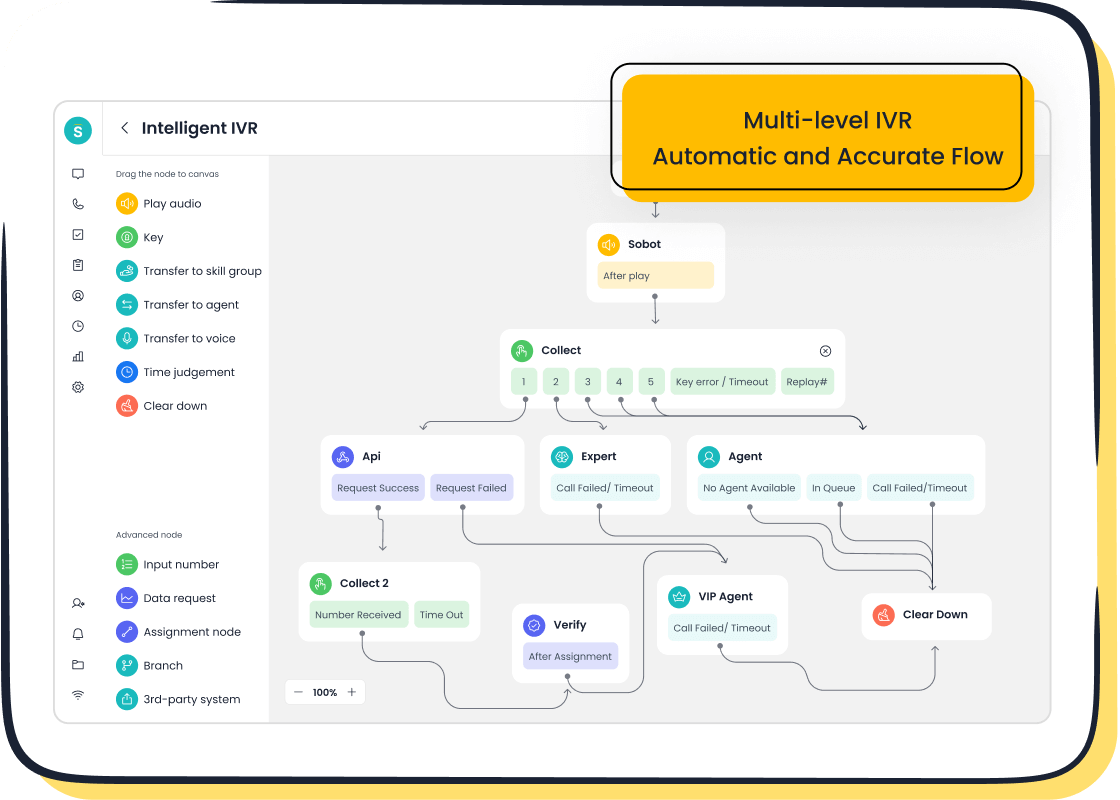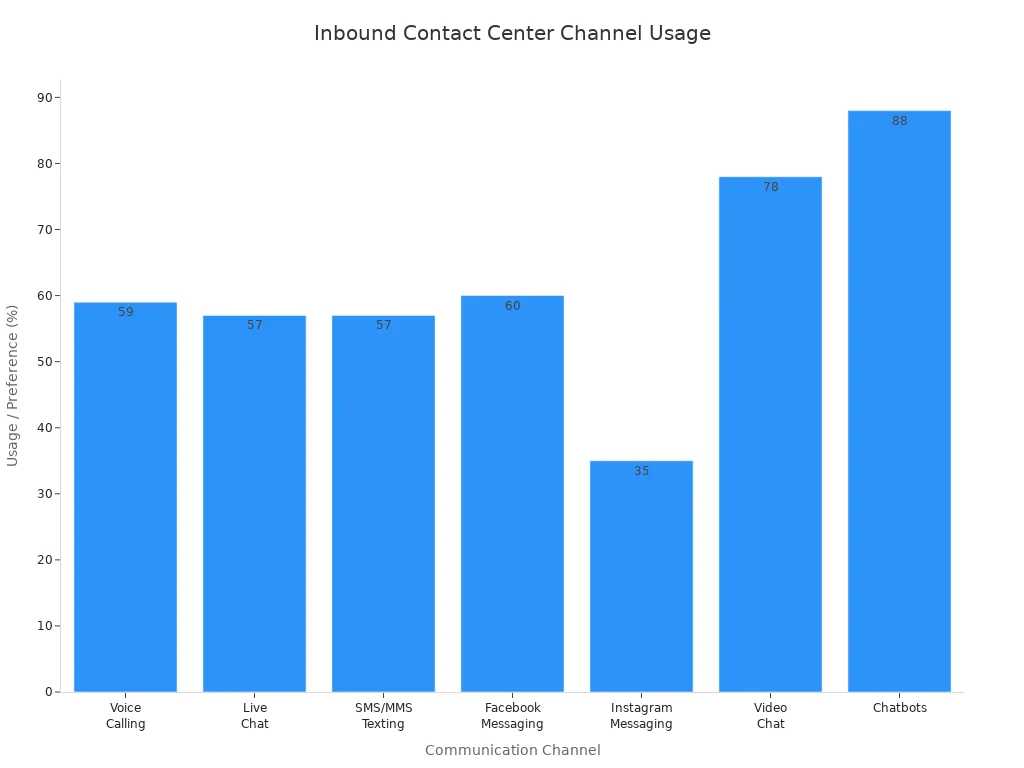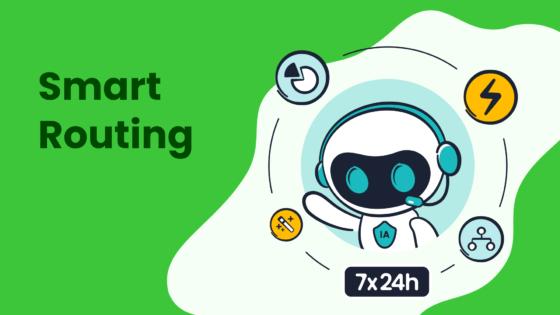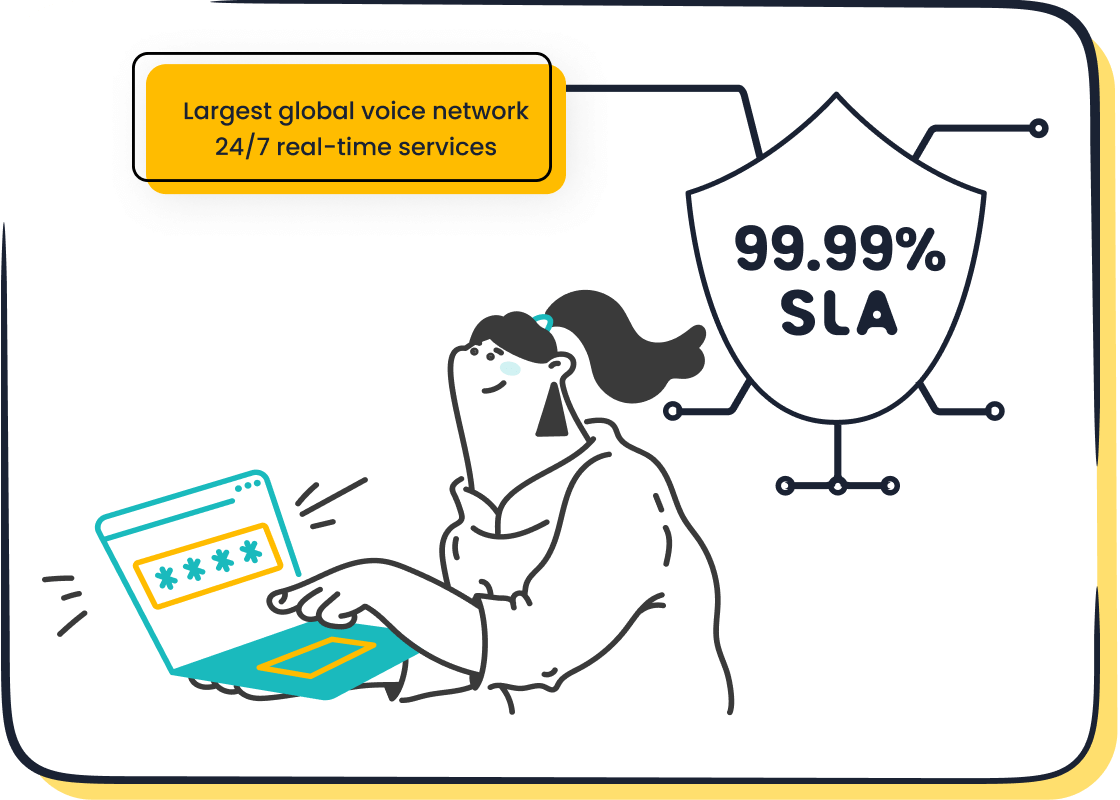Understanding Inbound Call Center Solutions in 2025

An inbound call center handles incoming customer calls, focusing on support, information, and service requests. In 2025, inbound call center solution platforms play a vital role in shaping customer service for businesses worldwide. The global call and contact center outsourcing market will reach nearly USD 102.89 billion by 2025, with inbound call center solutions holding the largest share source. Sobot stands out as a leading provider, offering advanced inbound and omnichannel solutions powered by Sobot AI.
Inbound call centers help businesses deliver excellent customer service by:
- Providing scalable, personalized, and professional support for every customer.
- Enabling companies to meet customer needs across multiple channels.
- Improving service quality, customer satisfaction, and loyalty.
A modern inbound call center solution, such as Sobot call center, empowers organizations to manage high customer demands, enhance service efficiency, and ensure consistent inbound support.
Inbound Call Center Basics
What Is an Inbound Call Center
An inbound call center is a specialized department or team that manages incoming calls from customers. In 2025, the inbound contact center focuses on delivering excellent customer service by answering questions, solving problems, and providing information. The main goal is to create a positive experience for every customer. Modern inbound call center services use advanced technology, such as AI-powered tools and cloud platforms, to handle calls efficiently. These centers measure success with metrics like Net Promoter Score (NPS), Customer Satisfaction (CSAT), and Customer Effort Score (CES). They also invest in agent training, automation, and real-time analytics to improve service quality and operational agility.
Tip: A strong inbound contact center builds trust and loyalty by making every customer interaction smooth and helpful.
Inbound vs Outbound Centers
Inbound and outbound call centers have different roles. The table below shows the main differences:
| Aspect | Inbound Call Centers | Outbound Call Centers |
|---|---|---|
| Call Direction | Handle incoming calls from customers | Initiate outgoing calls to customers or prospects |
| Operational Focus | Customer service, support, relationship building | Sales, lead generation, marketing, market research |
| Nature of Interaction | Reactive: respond to customer needs and issues | Proactive: initiate contact to promote products |
| Agent Skills | Empathy, problem-solving, support | Sales skills, persuasion, communication |
| Typical Activities | Taking orders, resolving issues, answering questions | Cold calling, telemarketing, lead generation |
| Goals | Provide excellent service, resolve concerns quickly | Generate sales, leads, and market insights |
Inbound contact centers focus on helping customers and solving their problems, while outbound centers focus on reaching out for sales or surveys.
Common Use Cases
Inbound call center services support many industries and business needs. The table below highlights common use cases:
| Use Case | Description | Industry Examples |
|---|---|---|
| Customer Service | Handling inquiries, support, scheduling, cancellations, and general assistance | Retail, general business |
| Marketing & Inbound Sales | Responding to campaigns and sales inquiries, such as product promotions and offers | Marketing, retail |
| IT Help Desk | Providing technical support for software, systems, and IT-related issues | Technology, IT departments |
| Feedback Collection | Gathering customer feedback and satisfaction surveys | Retail, service industries |
| Finance | Managing billing, accounts, payments, and refund inquiries | Finance, corporate services |
Inbound contact centers lay the foundation for advanced customer service strategies. Skilled agents, quality assurance, and modern technology help companies deliver seamless service across all channels. These basics support business growth and high customer satisfaction.
Key Functions of Inbound Contact Centers

Customer Support
An inbound contact center provides essential customer support for businesses in every industry. Agents answer customer service requests, resolve issues, and guide people through problems. They listen carefully and respond with empathy. This approach builds trust and improves the customer experience. Many inbound contact centers use advanced tools to track customer interactions and measure satisfaction. These centers focus on first call resolution, which means solving problems during the first conversation. This method saves time and increases customer satisfaction. A strong customer support team helps companies keep customers happy and loyal.
Order and Inquiry Handling
Order processing and handling customer inquiries are key functions of any inbound contact center. Agents manage sales, returns, and product questions. They use technology to make these tasks efficient and accurate. Here are some ways inbound contact centers handle these responsibilities:
- Agents receive training to provide personalized service and build strong relationships.
- Automatic Call Distributors (ACD) route calls to the right agent quickly.
- Customer Relationship Management (CRM) systems store detailed records for each customer.
- Centers offer 24/7 availability, so customers get help anytime.
- Agents process orders and solve problems right away.
- Metrics like First Call Resolution (FCR) and Average Handle Time (AHT) help improve efficiency.
- Centers collect insights from customer interactions to improve service.
Inbound contact centers serve many industries, including e-commerce, healthcare, and finance. They handle tasks such as order inquiries, returns, technical support, and appointment scheduling.
Multichannel Communication
Modern inbound contact centers use many channels to connect with customers. Voice calls remain the most popular, but digital channels are growing fast. The table below shows common channels and their features:
| Channel | Usage / Preference Statistics | Key Features / Notes |
|---|---|---|
| Voice Calling | 59% of consumers prefer voice as their channel | Traditional channel, supports empathy and rapport; enhanced by VoIP, PBX, call routing, IVR, AI voicebots |
| Widely used but specific stats not provided | Standard digital communication channel | |
| Live Chat | Part of 57% customers preferring digital channels | Real-time text communication on websites |
| SMS/MMS Texting | Included in 57% digital channel preference | Mobile messaging for quick, direct communication |
| Social Media Messaging | Facebook (60%), Instagram (35%) usage for customer service | Popular among younger demographics; platforms include Facebook, Twitter, Instagram, WhatsApp, etc. |
| Video Chat | 78% of large businesses consider video essential | Growing rapidly for complex issues needing visual interaction; builds trust via body language |
| Web Forms | Usage not specified | Used for structured customer input |
| Virtual Assistant/IVR | Highest first call resolution rate among channels | Automated call routing, AI-enhanced, supports self-service and payment integration |
| Chatbots | 88% of consumers have interacted with chatbots | Handles routine inquiries 24/7, escalates to live agents when needed |

A multichannel approach lets inbound contact centers meet customers where they are. This strategy improves the customer experience and ensures every customer receives timely support.
How Inbound Call Centers Work
Call Routing and IVR
Inbound call centers use advanced technology to manage calls efficiently. Intelligent IVR (Interactive Voice Response) systems greet customers and guide them through menu options. These systems use natural language processing to understand customer requests. Sobot Voice/Call Center offers a drag-and-drop IVR builder, making it easy to set up custom greetings and call flows. Smart call routing sends calls to the right agent or team based on skills, language, or priority.
Here is a table showing common technologies for call routing and IVR in 2025:
| Technology | Key Features | Top Providers |
|---|---|---|
| Interactive Voice Response (IVR) | Natural language processing, self-service, intelligent call routing | Sobot, Genesys Cloud, Five9 |
| Automatic Call Distribution (ACD) | Skill-based routing, priority queuing, real-time monitoring | Sobot, Talkdesk, 8×8 |
| Cloud-Based Omnichannel CCaaS | Unified channels, CRM integration, omnichannel support | Sobot, Talkdesk, Amazon Connect |
Sobot’s AI-powered voicebot can answer routine questions and direct calls, reducing wait times and improving customer satisfaction.
Agent Workflow
Agents in an inbound call center use a unified workspace to manage calls and customer information. Sobot provides a single platform where agents see all customer interactions, including previous calls, chat messages, and tickets. This helps agents respond quickly and accurately. Real-time monitoring tools let supervisors track performance and offer support when needed.
The Weee! customer story shows how Sobot improved workflow. Weee! used Sobot’s flexible IVR and integrated workbench. This change increased agent efficiency by 20% and cut resolution time by 50%. Agents could handle more calls and provide better service to every customer.
Customer Journey
The customer journey in an inbound call center includes several key stages. Each stage shapes how customers feel about the service.
- Awareness: Customers learn about the brand or service.
- Consideration: Customers compare options and reach out with questions.
- Decision: Customers make a purchase or take action.
- Loyalty: Customers return for more service and share positive feedback.
Inbound call centers map every customer touch point, gather data from calls and digital channels, and collect feedback from agents. This process helps improve customer interactions and ensures a smooth journey from start to finish.
Inbound Call Center Solutions in 2025

Sobot Voice/Call Center

Sobot delivers a comprehensive inbound call center solution designed for businesses that demand reliability, scalability, and seamless integration. The platform supports organizations across retail, finance, gaming, education, and enterprise services. Sobot’s system stability reaches 99.99% uptime, ensuring that inbound calls are never missed and customer service remains uninterrupted. The global network spans 110 points of presence in 93 cities across 50 countries, allowing companies to serve customers worldwide without latency or downtime.
Agents use Sobot’s unified workspace to manage inbound calls, chat messages, tickets, and customer data in one place. This workspace streamlines workflows and reduces the need for switching between systems. Sobot’s intelligent IVR greets callers, builds custom menus, and routes calls to the right agent or team. The drag-and-drop interface enables real-time updates, so businesses can adapt quickly to changing needs.
Sobot’s inbound call center solution integrates with existing CRM and technology management systems. This integration ensures that customer information is always up to date and accessible. The platform supports encrypted data transfer and dialing, protecting sensitive information and maintaining compliance with regulations such as TCPA and PCI DSS. Sobot’s mobile compatibility allows agents to answer inbound calls from anywhere, using Android or iOS devices.
Note: Sobot’s all-in-one inbound call center solution provides global telephony contacts, software, phone numbers, SMS, WhatsApp, and phone sets, making it a one-stop platform for business communication needs.
For more details, visit Sobot Voice/Call Center.
Key Features Table
| Feature | Description | Benefit |
|---|---|---|
| 99.99% Uptime | High system stability and reliability | No missed calls, uninterrupted service |
| Global Network | 110 points of presence in 93 cities, 50 countries | Worldwide reach, low latency |
| Intelligent IVR | Custom greetings, menu building, real-time routing | Personalized caller experience |
| Unified Workspace | All customer interactions in one platform | Efficient workflow, faster resolutions |
| AI-powered Voicebot | Intent recognition, routine inquiry handling | Reduced agent workload, faster answers |
| Secure Integration | Encrypted data transfer, CRM compatibility | Data protection, regulatory compliance |
| Mobile Compatibility | Android and iOS support | Flexible agent access |
Sobot’s inbound call center solution helps businesses handle millions of inbound calls daily. The platform’s stability and integration capabilities make it a trusted choice for brands like Samsung, OPPO, Weee!, and Michael Kors.
AI and Automation
Artificial intelligence transforms inbound call center operations in 2025. Sobot’s platform leverages AI to automate routine tasks, enhance agent performance, and improve customer satisfaction. AI listens to voice and digital interactions, providing real-time suggestions to agents. These tools add empathy to conversations, recognizing sensitive situations and guiding agents to respond appropriately.
Generative AI automates common tasks such as drafting follow-up messages, creating promotional content, and responding to customer emails. This automation reduces human error and ensures consistent, on-brand communication. For example, an online retailer can use generative AI to send personalized follow-up emails after a purchase, analyzing order details to create helpful messages. Agents focus on complex issues while AI handles repetitive tasks.
Healthcare call centers benefit from AI-powered chatbots that automate appointment scheduling, patient onboarding, and prescription refills. Generative AI summarizes previous interactions, helping agents manage complex cases efficiently. Smart routing capabilities allow chatbots to direct patients to the right specialists by understanding nuanced symptoms, streamlining inbound call handling and improving patient experience.
Process and task mining use AI to identify hidden inefficiencies in business workflows. These technologies help inbound call centers understand if processes are executed consistently and what should be prioritized for automation. Smarter automation strategies lead to improved operational accuracy and speed.
AI Technology Table
| AI Technology / Role | Description | Impact on Inbound Call Center Operations |
|---|---|---|
| Agentic AI | Autonomous AI systems perform tasks independently, supporting agents | Handles routine and complex tasks, improves efficiency |
| Generative AI | Automates content creation and customer communication | Reduces error, ensures consistency, frees agents for complex work |
| Robotic Process Automation (RPA) | Intelligent systems automate complex operations | Increases accuracy, automates workflows |
| Natural Language Processing (NLP) | Enables better comprehension and interaction through chatbots and voicebots | Enhances satisfaction and efficiency |
| Process and Task Mining | AI-driven analysis uncovers inefficiencies | Enables smarter automation strategies |
| Real-time Agent Assistance | AI provides live guidance and empathy cues | Optimizes customer experience and agent productivity |
| Vertical AI Agents | Specialized AI for industry-specific tasks | Delivers relevant automation solutions |
| IT Infrastructure Automation | AI optimizes resource allocation and scaling | Improves reliability and efficiency |
Sobot’s AI-powered voicebot interacts with callers, recognizes intent, and answers routine questions. Real-time agent assistance tools provide live guidance and empathy cues, helping agents deliver better service. These AI features optimize the customer experience and agent productivity.
Omnichannel Integration
Omnichannel integration is essential for inbound call center solutions in 2025. Sobot’s platform connects voice, chat, email, SMS, WhatsApp, and social media, allowing customers to reach businesses through their preferred channels. The unified workspace records interaction history across all touchpoints, giving agents a complete view of the customer journey.
Omnichannel integration enables seamless transitions between channels. Customers do not need to repeat information when switching from phone to chat or email. Agents can pivot conversations to more appropriate channels, such as sending links via text during a call. Customers manage their preferred contact methods for different communication types, increasing convenience and satisfaction.
Organizations using omnichannel strategies report a 91% higher year-over-year customer retention rate (Aberdeen Group). Additional benefits include improved first-call resolution rates, reduced average handle times, and higher customer satisfaction scores. These improvements enhance operational efficiency, customer experience, and business outcomes.
Tip: Omnichannel integration helps inbound call centers deliver consistent, personalized service across all channels, boosting loyalty and retention.
Omnichannel Benefits List
- Seamless transitions between communication channels
- Comprehensive view of customer journey for agents
- Customers manage preferred contact methods
- Agents pivot conversations to appropriate channels
- Improved first-call resolution rates
- Reduced average handle times
- Higher customer satisfaction scores
- Enhanced operational efficiency and business outcomes
Sobot’s omnichannel solution uses AI-driven automation to handle repetitive queries, freeing agents to focus on complex issues. The platform integrates with systems like Salesforce and Shopify, supporting multiple communication channels and providing data analytics for performance monitoring. Businesses optimize resource allocation and improve service quality with proactive insights.
Data Security and Privacy in Inbound Call Centers
Inbound call center solutions in 2025 prioritize data security and privacy. Sobot’s cloud telephony platform provides encryption and advanced security features, protecting customer data. The system complies with regulations such as TCPA and PCI DSS, helping organizations avoid fines and maintain trust.
Call centers install firewalls with call filtering capabilities to prevent external threats like Telephony Denial-of-Service attacks. Insider threats from employees, temporary agents, IT support, and third-party providers are addressed by restricting unauthorized access. Cloud-hosted auto dialer software with Do-Not-Call and Do-Not-Disturb list filtering helps avoid regulatory violations.
Continuous monitoring and improvement of data security strategies ensure privacy and protect customer data effectively. Sobot’s encrypted data transfer and secure integration features provide peace of mind for businesses and customers.
Real-World Impact: Sobot and Weee!
Weee!, America’s largest online Asian supermarket, partnered with Sobot to enhance its inbound call center operations. The company faced challenges such as inflexible IVR systems and language barriers. Sobot’s solution included a flexible IVR, integrated workbench, and multilingual support. Agent efficiency increased by 20%, and resolution time dropped by 50%. The customer satisfaction score reached 96%. Sobot’s inbound call center solution helped Weee! serve a diverse customer base and improve service quality.
For more on Weee!’s success with Sobot, see Sobot Customer Story: Weee!.
Why Sobot Leads in Inbound Call Center Solutions
Sobot’s inbound call center solution stands out for its reliability, global reach, and integration capabilities. The platform supports millions of inbound calls daily, helping businesses deliver excellent customer service. AI and automation optimize workflows, reduce agent workload, and improve customer satisfaction. Omnichannel integration ensures seamless communication across all channels. Data security features protect sensitive information and maintain compliance.
Sobot’s commitment to innovation, customer-centricity, and efficiency makes it a leading provider of inbound call center solutions in 2025. Businesses trust Sobot to enhance customer interactions, improve operational efficiency, and drive growth.
Benefits of Inbound Call Center Solution
Customer Satisfaction
Inbound call center solutions play a key role in raising customer satisfaction. Companies use advanced tools to improve the customer experience at every step. Metrics such as first call resolution, average handle time, and Net Promoter Score help teams measure and boost satisfaction. The table below shows how these strategies impact customer satisfaction:
| Metric / Strategy | Description | Impact on Customer Satisfaction |
|---|---|---|
| First Call Resolution | Solves issues on the first call | Increases satisfaction, reduces follow-ups |
| Smart Call Routing | Connects customers to the right agent quickly | Lowers hold times, improves experience |
| Customer Satisfaction | Collects direct feedback | Guides service improvements |
| Net Promoter Score | Measures loyalty and likelihood to recommend | High scores show strong satisfaction |
| Self-Service Options | Offers chatbots and IVR for quick answers | Reduces wait times, boosts satisfaction |
Recent studies show that 45% of customers feel annoyed if kept waiting 5-15 minutes, and 34% abandon calls if not answered quickly (source). By reducing hold times and resolving issues on the first call, inbound call centers create a positive customer experience and higher customer satisfaction.
Efficiency and Cost Savings
Inbound call center solutions help businesses work smarter and save money. AI-powered insights and automation let agents handle more calls in less time. Companies use cloud-based systems and omnichannel support to streamline service and reduce costs. Optimizing average handle time and agent utilization ensures teams stay productive without burnout.
Tip: Investing in modern tools like Sobot’s unified workspace and AI voicebot can boost efficiency and lower operational costs.
Efficient workflows mean fewer repeat calls and faster resolutions. Self-service options, such as knowledge bases and chatbots, allow customers to solve simple problems on their own. This reduces call volume and frees agents to focus on complex issues. Lower call abandonment rates and improved agent performance lead to better customer satisfaction and cost savings.
Scalability
Scalability is vital for growing businesses. Inbound call center solutions allow companies to handle high call volumes during busy times. Teams can add more agents, use AI-powered chatbots, and optimize workflows to meet demand. Predictive analytics help forecast call spikes, so managers can allocate resources ahead of time.
- Adding agents during peak periods ensures enough staff for customer service.
- AI chatbots automate routine questions, reducing agent workload.
- Intelligent call routing directs calls to the best agent, improving efficiency.
- Omnichannel support meets customers on their preferred platforms.
- Real-time monitoring helps teams spot and fix bottlenecks quickly.
- Self-service tools empower customers to find answers, reducing call volume.
These features help businesses maintain high service quality and customer satisfaction, even as they grow or face seasonal surges. Sobot’s cloud-based platform supports global operations, making it easy for companies to scale customer service as needed.
Best Practices for Inbound Contact Centers
Training and Quality
Training shapes the success of every inbound contact center. Agents learn how to handle inbound calls, solve problems, and use technology. Managers set clear objectives for the team. They assess current performance and identify areas for improvement. Regular training sessions help agents build empathy, communication skills, and product knowledge. Quality assurance teams listen to calls and review chat transcripts. They give feedback and coach agents to improve service. Companies use both financial and non-financial KPIs to measure quality. These include customer satisfaction scores, first call resolution rates, and agent productivity. A strong focus on training and quality ensures that every inbound contact center delivers excellent service.
Technology Adoption
Inbound contact centers in 2025 use advanced technology to improve efficiency and customer experience. The latest trends include:
- Artificial Intelligence (AI): Chatbots, generative AI, and IVR systems automate routine inquiries.
- Cloud Migration: Supports hybrid workforces and remote access.
- Speech Analytics: Real-time understanding of customer emotions.
- Automatic Queuing and Routing: Skills-based routing and predictive analytics.
- Personalization: AI and CRM integration for tailored experiences.
- Omnichannel Communication: Multiple platforms in a single hub.
- Analytics and Reporting: Actionable insights for workforce optimization.
- Security: Data loss prevention and encryption.
- Video Conferencing: Enhances support quality.
Sobot’s inbound contact center platform integrates these technologies, helping agents work smarter and customers get faster answers. Companies use visual dashboards and reports to track performance and spot trends.
Performance Metrics
Performance metrics show how well an inbound contact center operates. First Call Resolution (FCR) measures the percentage of issues solved during the first inbound interaction. High FCR rates mean agents resolve problems quickly, which boosts customer satisfaction and lowers costs. Average Handle Time (AHT) tracks the total time spent on each inbound call, including talk, hold, and after-call work. Lower AHT suggests efficient handling, but managers balance speed with quality. Measuring KPIs by industry helps businesses compare their inbound contact center to others, find strengths and weaknesses, and improve strategies. Companies use advanced software tools with AI automation, visual dashboards, and secure integrations to analyze these metrics and optimize operations.
Tip: Tracking FCR and AHT helps managers identify training needs, optimize staffing, and improve customer satisfaction in every inbound contact center.
Inbound call center solutions in 2025 help companies deliver excellent customer service and improve customer satisfaction. Sobot provides advanced technology that supports omnichannel platforms, automation, and analytics. Key takeaways include:
- Automation and smart routing improve customer satisfaction and reduce costs.
- Quality assurance and ongoing training boost customer service.
- Cloud-based systems offer scalability and support remote work.
- Customization meets unique customer needs across industries.
- Data-driven decisions enhance customer engagement and satisfaction.
Innovation and customer-centricity will shape the future, helping businesses build lasting relationships with every customer.
FAQ
What is an inbound call center solution?
An inbound call center solution helps businesses manage incoming customer calls. It uses technology like IVR, smart routing, and unified workspaces. Sobot provides these features to improve customer service and agent efficiency.
How does Sobot ensure data security for inbound calls?
Sobot uses encrypted data transfer and secure integrations. The platform follows regulations such as TCPA and PCI DSS. This protects customer information and helps companies stay compliant.
Can Sobot integrate with existing CRM systems?
Yes, Sobot offers seamless integration with popular CRM platforms. Agents access customer data in one workspace. This improves workflow and helps teams deliver faster support.
What industries benefit most from inbound call center solutions?
Retail, finance, gaming, education, and enterprise services use inbound call center solutions. Sobot supports these industries with global reach and reliable uptime.
How does AI improve inbound call center operations?
AI automates routine tasks, provides real-time agent assistance, and enhances customer interactions. Sobot’s AI-powered voicebot answers common questions and routes calls efficiently.
